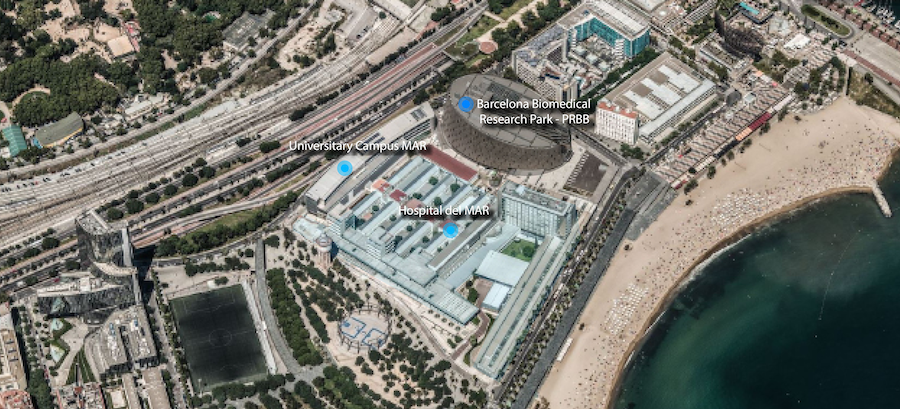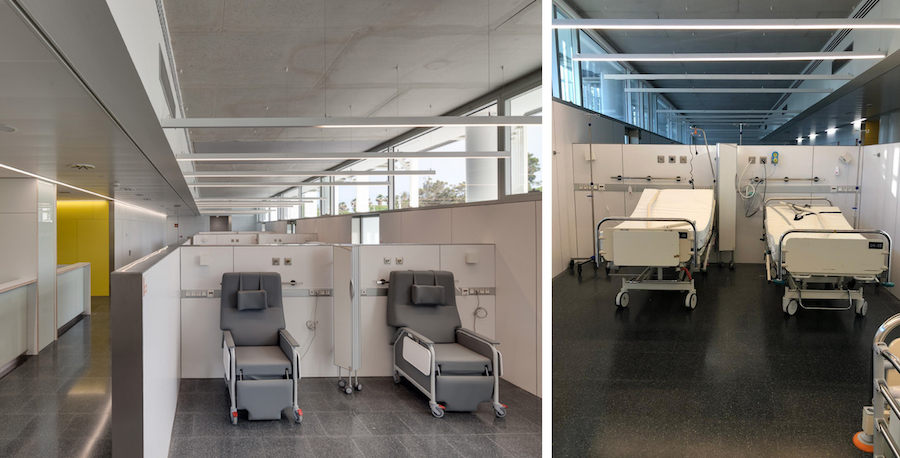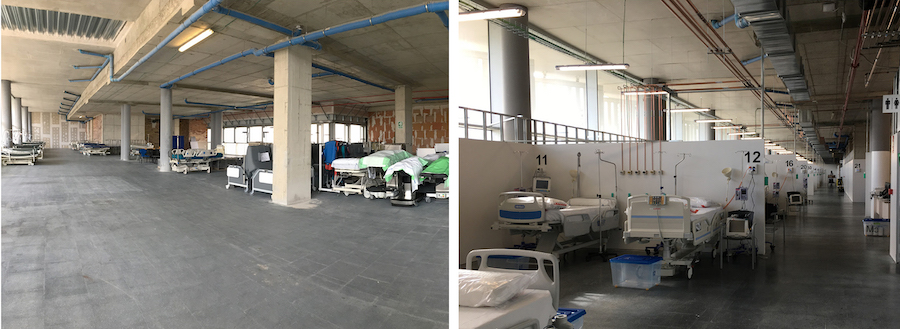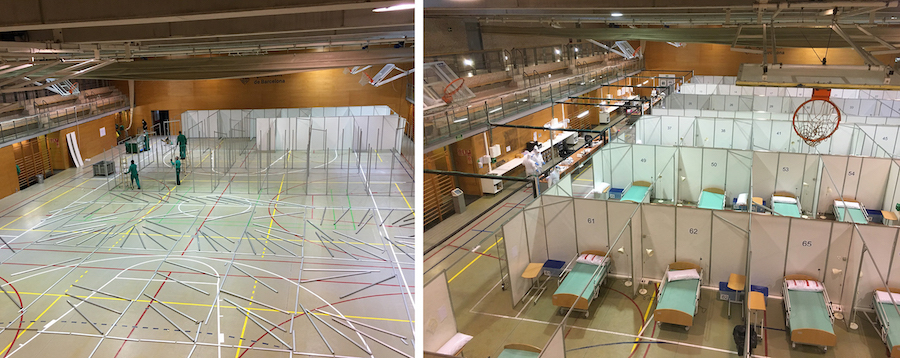Healthcare / Service redesign
Design strategies for the COVID-19 pandemic in Hospital del Mar
By Andrew Sansom | 06 May 2020 | 0
Abraham Jiménez looks at the strategies deployed by Hospital del Mar, a major health institution in Barcelona, a city heavily impacted by COVID-19.
The current health global emergency has required a substantial restructuring of hospitals’ processes and the conversion of other building types, such as hotels, convention centres and sport pavilions, into healthcare facilities. Although critical to providing widespread care, these adapted buildings stretch the resources of permanent healthcare facilities as they’re usually not located in close proximity to hospitals. They increase the needs for technical infrastructure, require ambulance connections and relocation of staff, and can add extra stress to already battered medical teams.
The crisis highlights the strengths and weakness of different design approaches to healthcare facilities, not just at the building scale but also in their urban context.

As with most hospitals in Spain, Hospital del Mar had to adapt to the surge in demand of beds for hospitalisation and for ICU beds due to the emergency. However, contrary to the strategy of expanding capacity to facilities in other locations, Hospital del Mar has built a contingency plan to reorganise internally and grow to neighbouring buildings, enhanced by a flexible architectural design and a cohesive urban organisation.
Eight-step programme
To cope with the expected wave of admissions, Hospital del Mar devised an eight-step programme to handle the demand for beds for COVID-19 patients in the infectious diseases ward, located on level nine of the hospital tower; the programme was also devised to gradually occupy all lower levels of the building, moving other services to spaces reorganised in Building B, the latest addition to the Parc de Salut Mar (PSMar) Healthcare complex. In this way, Building B provides augmented bed capacity in areas that have no contact with the virus, including two surgical rooms and the gyneco-obstetrics zone. This prepared the hospital for the surge of demand for beds when returning to normal activities while still treating numerous COVID-19 cases.
The clear spatial relations and modular design of Building B allowed a fast deployment of 50 beds in one treatment area of the day hospital and 70 other beds on the first floor, in a large open area reserved for future offices. The building’s flexibility to adapt to the new programme has been possible thanks to a clear plan layout of areas for treatment, circulations and technical and service spaces, as well as the gas and electrical connections already in place to support this shift.
The building’s modular structure favours open spaces and naturally lit rooms, helping make the experience for new and transferred patient less stressful. Moreover, the building has an air quality monitoring system developed in collaboration with Pinearq. This prototype solution can provide real-time data of environmental health and insight for protocols in future pandemics.


Expansion outside the hospital walls
Because of the wide spread of COVID-19 in Barcelona, the hospital’s contingency plan also involved an expansion outside its walls to add temporary hospitalisation wards for coronavirus patients.
The hospital is located within an urban parcel, which also includes the University Campus Mar, the Barcelona Biomedical Research Park (PRBB) and a municipal sports centre. This superblock was designed as a health sciences cluster linking the hospital to teaching and research institutions, and bringing together all the elements that define the evolution of healthcare. PSMar is the public consortium that links all components of this biomedical hub.
The integrated design of the different components of the cluster has supported the connection of complementary facilities and programmes, enabling Hospital del Mar to extend its bed capacity to the neighbouring basketball court of the municipal sport centre. Located in basement -3 of the PRBB building, the hospital has set up two 72-bed wards divided into two units with respective nurse controls.
The plan to design and build this expansion was co-ordinated by a team comprising the Hospital del Mar, the municipal government, the local fire department, and Doctors without Borders (MSF), with the support of Pinearq. All the work to deploy and technically connect these provisional facilities was carried out in one week. The area is now managed by a 25-strong team from the hospital.
Movement of patients
Clear and organised technical and spatial connections between the neighbouring buildings have greatly simplified the movement of patients at different stages of the virus, from the ICUs and wards in the hospital to the temporary wards for recovery before medical release. The provisional areas are physically linked to the hospital by secured connections that allow the transfer of patients on a stretcher without the need for an ambulance; a one-minute journey from the hospitalisation tower within an isolated connection that ensures no contamination of other patients and areas of the hospital.
Patients from the hospitalisation tower are brought down in elevators and transferred through a special isolated corridor built on the ground-level esplanade of the superblock. This connects to the elevator in the PRBB building to take patients to the recovery units. Medical staff and clean supplies use a corridor connection between the two buildings in basement -1 to reach the wards. This double circuit eliminates contamination hazards and secures the safety of patients and staff in the whole hospital.
Learning from other countries
The hospital was able to roll out this expansion strategy in a very short time, using the experiences in China and Italy as references for planning for a probable overflow of cases.
The speed and efficiency in executing the expansion plan were enhanced by the existing connections and the complementary programmes between the superblock’s buildings. These design features allowed for faster solving of any technical issues to provide necessary equipment and data, gas and water networks, as well as setting up the connections for patients and staff transfer, and defining clean and soiled circuits. Additionally, the complementary programmes of the neighbouring buildings made it easier to implement additional infrastructure, such as oxygen tanks and air conditioning machines and ducts.

Up to this point, only one of the units in the municipal sport complex has been put into operation to house rehabilitating patients in the latest stages of recovery. However, there is no foreseeable closure date for these provisions, as the hospital’s management and staff prepare for a possible second wave of admissions as Spain’s lockdown measures loosen.
This rapid response proves the advantages of modular and flexible architecture and an urban logic that promotes the connection of facilities with complementary programmes. In the case of Hospital del Mar, these design strategies have greatly facilitated the reorganisation of its clinical services to cope with a worldwide pandemic, offering valuable lessons in how to design infrastructure to face the health challenges of today and the future.
Abraham Jiménez is head of service innovation at Pinearq, an international firm of architects specialising in developments for health sciences, based in Barcelona, Spain.
Organisations involved
